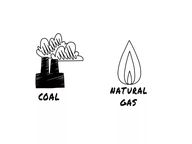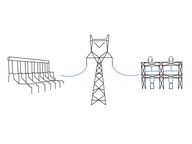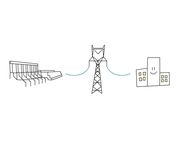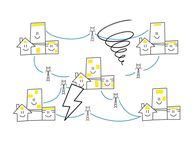Nearly all of the electricity we produce is generated at 16 hydroelectric generating stations on the Nelson, Winnipeg, Saskatchewan, Burntwood and Laurie rivers.
The province’s remaining electricity needs are fulfilled by:
- 1 thermal generating station;
- 4 remote diesel generating stations;
- wind power purchases from independent wind farms in Manitoba.
Electricity transmission & distribution
We deliver 30 billion kilowatt-hours of electricity over 11,045 km of transmission lines and 75,320 km of distribution lines on average every year.
Our transmission system moves electricity from generating stations around the province in a range from 24 kilovolts (kV) to 500 kV. Major high voltage transmission lines operate at 115 kV, 138 kV, 230 kV, and 500 kV. The voltage is then reduced by large transformers at terminal stations to 66 kV, 33 kV or 24 kV.
Our distribution system is a network of power lines with overhead and underground conductor cables, transformer stations, transformers, voltage regulators, and oil circuit reclosers. It reduces higher voltages to useable levels – down to 120 V for our homes – and maintains a constant supply of power and steady voltage levels. Energy use varies throughout the day and can increase as much as 65% from summer to winter.
We operate alternating current (AC) and direct current (DC) transmission systems:
- AC is an electric current that reverses direction at regular intervals, or alternates from positive to negative, approximately 60 times a second. Most of the electricity used in the world is AC.
- DC is an electric current that flows in one direction. For long-distance transmission, power losses are considerably less with DC than with AC.
At a generating station, the turbine generators produce AC electricity. If travelling a long distance, we convert the electricity to DC at a convertor station close to the generating station. The electricity travels to another convertor station where we change it back to AC through an inversion process. AC electricity is then transmitted through our distribution network to our customers.
To learn more about Canada’s electricity industry, visit the Power for the Future website.
Natural gas transmission & distribution
We deliver around 2 billion cubic metres of natural gas to 130 communities across southern Manitoba every year. Most of that natural gas is brought in from Western Canada by a gas transportation pipeline owned by TransCanada Pipelines Limited (TCPL).
Natural gas is transferred into our system, comprised of 10,700 km of transmission and distribution pipelines, at several points along the TCPL pipeline. When natural gas is distributed to homes and businesses on our system, the pressure is first lowered at a regulating station.
We add mercaptan to the natural gas stream once it enters our system to help us find possible leaks. Mercaptan adds a bad smell – like rotten eggs – to the odourless natural gas.
For more information about our facilities and operations, contact us.
Electricity exports
Why we sell power
Revenue from our power exports brought in more than 22% of our total electric revenue 2010–19, or about $3.9 billion.
Every dollar we make goes back into running Manitoba Hydro to keep rates low for our customers in Manitoba.
We sell our power to utilities in the United States, and Saskatchewan and Ontario.
We sell our extra power to benefit you, our Manitoban customers. Without our export sales, your electricity rates would be about 20% higher than they are today.
We have an abundance of hydroelectric power. With our lakes and rivers, we can generate more electricity than we need in Manitoba — for now. The province is steadily growing and we will need this surplus power to meet future demands.
So until we need this power for our own needs, we sell it.
We’ve built the Keeyask generating station for projected power use in Manitoba. Until that demand catches up to what we have projected, we will sell the excess electricity.
To deliver this excess power to increase our export sales, we built the Manitoba–Minnesota Transmission Project, which went into service June 1, 2020. We also built the Birtle Transmission Project, which went into service March 29, 2021.
Retail vs. wholesale
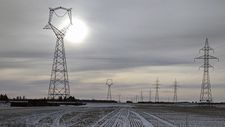
We built the Manitoba–Minnesota Transmission Project to increase the reliability of Manitoba’s electricity supply.
Enlarge image: Transmission lines standing in wintery farm fields.
When we export our power, we are selling bulk wholesale electricity in two ways: firm and surplus.
“Firm” means we have negotiated, long-term contracts to sell our power at fixed prices to neighbouring utilities. Long-term firm prices are negotiated based on the potential cost of the export customer building and operating their own generating station.
“Surplus” means extra power we can sell on top of our firm sales, but at a lesser price. Since the amount of energy available for surplus or spot sales can change in a short period of time, prices change rapidly and no sale is guaranteed.
We export wholesale power straight to other utilities. We send power from our hydroelectric generating stations over long transmission lines straight to our export customers. It is up to them to distribute that power to their customers.
What we sell to Manitobans is retail power.
“Retail” power is what you pay us to generate the power, carry it down our transmission lines, and then covert it to low-voltage electricity delivered to your house.
Your retail power price reflects the cost for us to generate and bring this power to you, plus all the costs of maintaining and improving our grid. Your price ensures when you turn on a light, it’s always there.
Wholesale costs don’t reflect this. Our export customers get power directly from the bulk transmission grid, and are not responsible for Manitoba Hydro’s subtransmission system – the power to our substations – or the distribution costs of bringing power to your home.
Sell or spill
We have abundant rivers and lakes. The flow of water never stops. The potential to generate power from that water never goes away. Even if we don’t need the power, we can still generate and sell it.
Prices for opportunity sales in the United States have been lower in recent years. This is due to the increased use of low-cost natural gas to generate electricity, and expanded use of tax-subsidized wind turbines that produce energy at a low cost.
Moment-by-moment prices in the short-term export market also fluctuate widely, so our export revenues can vary greatly depending on the time of the day, water conditions, wind generation, and natural gas prices.
We still pursue surplus sales because they still bring in revenue and keep our rates some of the lowest in North America.
If we didn’t sell it, the alternative would be to send the water through the spillways of our generating stations instead of the turbines, which does not make money or help keep our rates low.
Exporting power can also lower greenhouse gases for neighbouring utilities. The more hydroelectric power our export customers buy from us, the less they have to use coal or natural gas to generate power.
We are also fortunate our neighbours have peak power seasons opposite ours. Manitobans use more power in winter than summer, which is the exact opposite to most of our export customers. In summer, when all our neighbours are using power to stay cool, we can sell them our surplus power.
So why do we sell power?
- We can generate extra electricity and not waste water.
- Our neighbours want to buy it.
- Our hydroelectric power can lower greenhouse gas emissions.
- Export sales revenue keeps rates lower for Manitobans.
If you have questions, email us.
View the Canada Energy Regulator snapshot of electricity exports to the United States. It shows that Canadian electricity trade with the United States is greater than provincial trade.
The value of electricity exports
Watch our video to learn more about transmission connections and the value of exports to our customers.
Renewable energy certificates
Nearly all of the electricity we produce each year is from sources using the power of flowing water or the wind.
We have sold renewable energy certificates (RECs) in the North American energy market for more than 15 years. When you purchase a REC, it shows you source your energy from self-renewing sources rather than fossil fuels.
How renewable energy certificates work
Each REC represents the environmental characteristics associated with one megawatt-hour of renewable electricity generation. We sell our RECs across North America to utilities and end-users such as large industrial/manufacturing companies. They can then claim they purchase renewable electricity to meet their jurisdiction’s legislated renewable energy targets or their corporate environmental and sustainability goals. Purchasing RECs is the only legitimate way for an organization to substantiate their procurement of renewable energy.
Our RECs are issued for every megawatt-hour of electricity generated from our 16 hydroelectric generating stations, two independent wind farms in southern Manitoba, and the solar PV panels on homes, businesses and farms across the province. Each REC is tracked and made available for transfer through M-RETS, a central electronic registry much like an online stock exchange. If you do not have an M-RETS account, we can act on your behalf.
We sell ECOLOGO®-certified RECs that are verified for reduced environmental and health impacts. We also sell RECs from facilities listed by the Centre for Resource Solutions, a global leader in clean energy certification.
Manitoba businesses and our interconnected neighbours have benefited from purchasing RECs to demonstrate how they are committed to purchasing energy generated from Manitoba’s self-renewing sources rather than fossil fuels.
To learn how RECs can help you, email us.
Wholesale power transactions
Effective December 21, 2024, the following are authorized negotiators and contacts for wholesale power transactions on behalf of Manitoba Hydro.
Wholesale Power Trading department
- Kelly Bertholet,
Wholesale Power Trading Department Manager
- General contact: 204-360-4818
- 24 hour desk: 204-360-4616
- Fax: 204-360-6137
Long Term Capacity & Energy Transactions
- Kelly Bertholet,
Wholesale Power Trading Department Manager - Lauren MacMillan,
Wholesale Power Marketing Section Head
Energy Trading and Sales
- Chris Guttormson (≤ 5 years)
Energy Trading & Sales Manager
Day Ahead Power Traders (≤ 1 month)
- Ryan Hehn
- Ryan Penner
- Mitch Rarog
- Dave Wells
- Dan Chevrier
Market Operations and Access
- Dave Wells,
Market Operations & Access Manager
Real time Power Traders (≤ 24 hours)
- Dan Chevrier
- Perry Ducharme
- Shontel Dutka
- Edwin Germann
- Boyan Zigich
- Bryan McGimpsey
Environmental attributes/RECs
- Lauren MacMillan,
Wholesale Power Marketing Section Head - Gary Sorba,
Wholesale Power Officer
Additional contact information
Not authorized to negotiate transactions on behalf of Manitoba Hydro:
- Candace Kreutzer,
Credit - Kendle Dubyts,
Settlements
Power sale arrangements
Basin Electric Power Cooperative
On March 1, 2019, we signed a 5-year agreement with Basin Electric Power Cooperative for the sale of up to 80 MW of capacity each year starting in June 2023.
Dairyland Power Cooperative
On December 31, 2020, we signed a 50 MW seasonal diversity exchange agreement with Dairyland Power Cooperative for a five-year term starting June 1, 2022.
Great River Energy
On October 24, 2013, we signed a 200 MW seasonal diversity exchange with Great River Energy of Minnesota that runs until 2030.
Seasonal diversity exchanges allow utilities whose peak loads occur in different seasons of the year to share surplus generating capacity during off peak seasons. This saves both utilities from building generating facilities that are only required at peak times, saving money for their customers.
The Great River Energy diversity exchange means we will provide 200 MW of hydroelectric power to Great River Energy in the summer to meet their annual peak energy needs, while Great River Energy will provide Manitoba Hydro with 200 MW of capacity during the winter when heating demands in Manitoba are the greatest.
Minnesota Municipal Power Agency
On June 1, 2018, we entered into an agreement with Minnesota Municipal Power Agency for the sale of up to 105 MW of annual capacity starting June 1, 2020.
Minnesota Power
On May 25, 2011, we announced an agreement with Minnesota Power for the sale of 250 MW of hydroelectric power each year over a 15-year period, beginning in 2020.
The sale also required the construction of a new international transmission line, the Manitoba–Minnesota Transmission Project in Canada and the Great Northern Transmission Line in Minnesota. The transmission line went into service June 1, 2020.
Northern States Power
On May 27, 2010, we signed 3 agreements with Northern States Power (part of Xcel Energy) to supply up to 850 MW of hydroelectric power from Manitoba each year until 2025. The 3 agreements consist of a 350 MW seasonal diversity exchange, a capacity sale for 375 MW in the summer and 325 MW in the winter, and an annual capacity sale for 125 MW.
On June 13, 2024, we signed two 5-year agreements starting May 1, 2025, with Northern States Power (part of Xcel Energy). The first agreement is a summer capacity sale for 200 MW. The second agreement is for an up to 350 MW seasonal diversity exchange agreement.
SaskPower
In 2020, we signed an agreement with SaskPower to provide up to 215 MW of hydroelectric power to Saskatchewan each year, beginning in 2022 and continuing for up to 30 years. The new sale will bring long-term benefits to electricity customers in both provinces. This is the largest of 3 recent major power deals between the 2 provinces. By 2022, Manitoba Hydro will be supplying up to 315 MW of hydroelectric power to Saskatchewan each year.
On January 29, 2016, we signed a 20-year agreement to sell 100 MW of hydroelectric power to SaskPower each year, starting in 2020. This sale required the construction of a new 230-kV transmission line from Birtle Station, south of the community of Birtle, to the Manitoba–Saskatchewan border. The Birtle Transmission Project was completed on March 29, 2021.
Wisconsin Public Service
In 2011, we announced an agreement with Wisconsin Public Service for the sale of 100 MW of hydroelectric power each year over the period from 2021–2027.
WPPI Energy
On January 12, 2024, we signed a 6-year 100 MW seasonal diversity exchange agreement with WPPI Energy starting June 1, 2024.
Independent power
- Jamie Hopkins,
Independent Power & Renewable Gas Section Head - Lindsay Maitland,
Energy Market Strategies Officer - Jan Peters,
Independent Power Officer
Converter stations
A lot of Manitoba’s electricity is produced by our northern hydroelectric generating stations on the Nelson River. The electricity travels long distances on bipole transmission lines to southern Manitoba as high-voltage direct current.
It is more efficient and economical to transmit electricity as high-voltage direct current. Our northern converter stations change alternating current (AC) to direct current (DC) for transmission, and our southern converter stations then change it back to AC.
Dorsey
Dorsey converter station is in Rosser and is the southern end point for Bipoles I and II. Over 70% of electricity produced in Manitoba is transmitted through Dorsey.
Dorsey received its first transmission from Bipole I in June 1972.
The converter station was named after Professor John Dorsey, who taught electrical engineering at the University of Manitoba from 1912 to 1952. Professor Dorsey was well known for his work on electrical transmission.
Henday
Henday converter station is north of Gillam and is the northern end point of Bipole II.
Henday first transmitted energy in October 1978 as part of Bipole II.
The station was named after Anthony Henday, an 18th century trader who worked for the Hudson’s Bay Company.
Keewatinohk
Keewatinohk converter station is northeast of Gillam and is the northern end point of Bipole III. Pronounced Kee-way-tin-oohk, the word is Cree for the north.
Keewatinohk first transmitted energy in April 2018 as part of Bipole III.
Radisson
Radisson converter station is north of Gillam and is the northern end point for Bipole I.
Radisson first transmitted energy in March 1971 as part of Bipole I.
Riel
Riel converter station is located east of Winnipeg. It is the southern end point for Bipole III.
Riel received its first transmission from Bipole III in July 2018.
Transmission explained
Learn more about transmission and its valuable role in delivering the reliable, affordable energy you count on.
What is transmission? How does it fit into our system?
Watch to learn where our electricity comes from and how it gets to the places we use it.
The value of electricity exports
Watch our video to learn more about transmission connections and the value of exports to our customers.
The value of reliability
Watch our video to learn more about transmission connections and the value they provide our customers by enhancing reliability.
Why does Manitoba need new transmission?
Watch to learn how the demand for electricity has increased and how we need to change our system to accommodate the growing need.
How do we develop transmission lines?
Watch to learn how we work with communities to minimize the effects of transmission lines on people and the environment.

